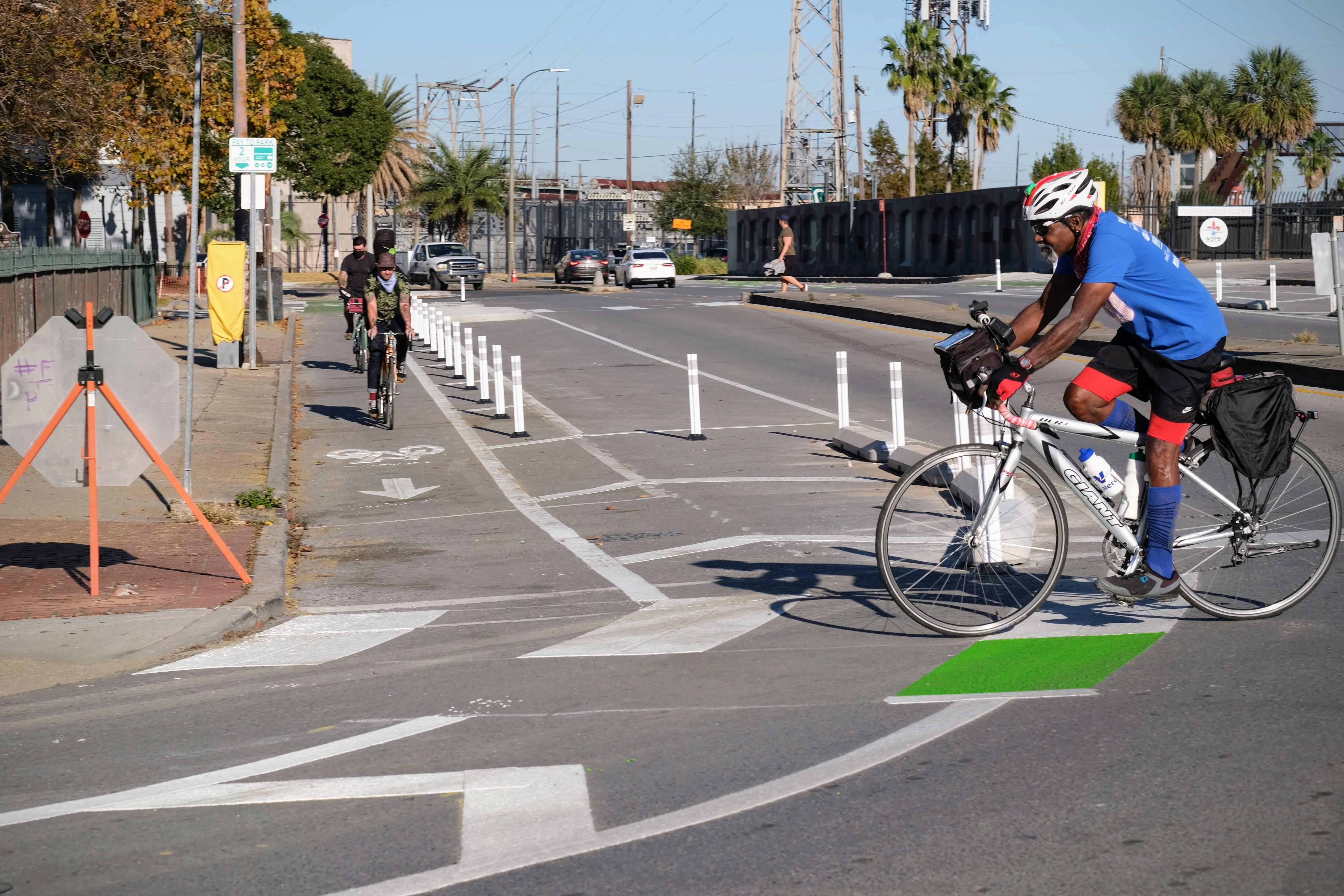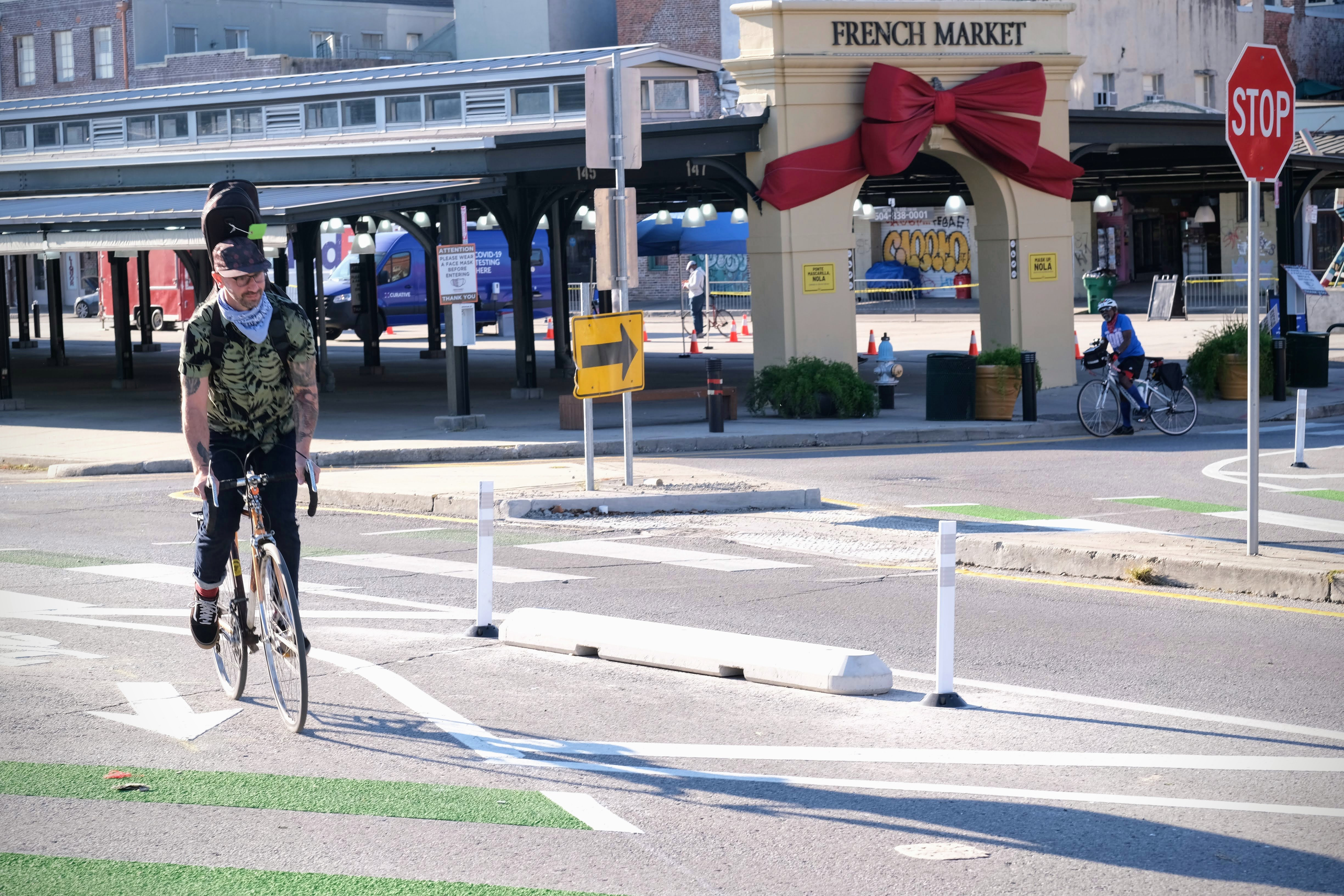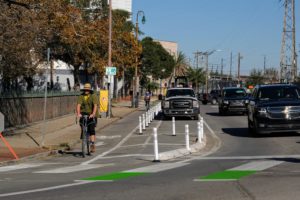
Today, thankfully, Elysian Fields has brand-new protected bikeways in both directions on this same previously unsafe stretch, creating a vision and blueprint for the rest of Elysian Fields as well as the rest of New Orleans and the region. Not only will these protected bikeways keep our biking community safe, they make biking to and from downtown and the French Quarter easy, safe, and fun for residents and visitors.
But enough talking about it, we want to show you what easy. safe, and fun biking on Elysian Fields looks like, and give you some practical pointers on how to navigate this new infrastructure whether biking and driving.




Bike Easy members and volunteers had a lot of fun riding the new bikeways in the photos above. Have you enjoyed them yet? If you have any photos, email them to our Communications Coordinator, Elon at elon@bikeeasy.org and we’ll feature them in our social media.
These protected bike lanes are just the beginning. This year, Bike Easy has been leading a campaign with the New Orleans Complete Streets Coalition to install and activate 75 miles of connected and protected bikeways, as part of the City’s Moving New Orleans Bikes plan.
Even with these plans in place, we need to keep organizing and educating our community around the importance of bike safety infrastructure, and especially how to use it.
What do these new bike lanes mean for you?

FOR PEOPLE BIKING…
- Plan out your route in advance – take advantage of this new infrastructure built for you! Use Google’s bike directions, the 2020 New Orleans Bike Map and Guide to Safe Cycling, or your own knowledge and experience to identify a low-stress bike route to your destination. Choose a route according to the reasons you’re riding; certain streets and bikeways are better for exercise and leisure than commuting for instance.
- Be Prepared. Make sure your bike is in good working order, meaning your tires are pumped up, your brakes work, and your chain and shifters are working correctly. Bring along tools and supplies needed to fix a flat tire. A preventable mechanical issue might cause you to crash, which ultimately might cause someone else in the bike lane to crash, too. Better to diagnose issues at home before they become a problem out on the road.
- Be aware of your surroundings. While in a protected or buffered bike lane you may be separated from car traffic, but pedestrians and other people on bikes can pose potential hazards. Be ready to brake if a dog or kid darts across the lane or stops suddenly. Be aware of people exiting or entering their vehicles who may be about to walk across the bikeway.
- Slow your roll. Bike lanes are designed to be accommodating for every day riders, which means you’ll see a variety of types of bikes and people on them. Feel free to pick up the pace if the lane is clear, but be courteous to others traveling by bike.
- Be Safe. Wear a properly-fitted helmet, dress appropriately for the weather, and make sure you’re carrying your phone, spare cash, your ID and your insurance card. Bike lights and reflectors are required by law and are especially important on dawn or dusk rides.
- Follow the rules and traffic patterns of the road. People on bikes fare best when they act as and are treated as drivers of vehicles – that means the same rules apply – respect signs and signals and ride predictably. Never ride against the flow of traffic in a bike lane – you’ll be putting people going with traffic in danger when they have to navigate around you. You can always get off your bike and walk on the sidewalk.
- Don’t block traffic. If you need to stop, pull off to the side of the bike lane, dismount and move to the sidewalk. This keeps traffic flowing and everyone that much safer.
- Pass correctly. Treat passing in a bike lane as you would in a car on the road. If you’re a slower rider, stay to the right. If you’re planning on overtaking another person on a bike, pass on the left. Once you’ve passed that rider, move back into the right lane and repeat as necessary.
- Alert other riders by using a bike bell, or shout out “passing on your left” as you pass a slower rider so you don’t startle them. Be warned that not all riders on the bike path are super confident on two wheels. Yelling “on your left” sometimes causes them to look over their shoulder and swerve left, so be cautious and watch your speed.
- Be kind. Everyone has their own story, and everyone in a bike lane means one less car on the road. Be encouraging to others on bikes as you pass by. Stop and offer mechanical assistance if you’re able to help.

FOR PEOPLE DRIVING…
- Park correctly. Parking spaces alongside these new bikeways have been shifted out from alongside of the curb. Park between the buffered zone with flex posts and the traffic lane.
- Pay attention when crossing a bike lane to exit or enter your vehicle. Watch out for people biking before entering the bikeway.
- Pay special attention at intersections and driveways – watch out for people on bikes entering the roadway or leaving a bike lane to make a turn. Yield and give people on bikes the right of way. Communicate and make eye contact with people on bikes at intersections to acknowledge their presence. Always signal your turns so they know your intentions. Remember that while bike lanes are a designated space for people riding bikes, people on bikes are not required to use them and may need to leave the bike lane to avoid an obstacle or to turn on to another street.
- Use cautious turning. Bike lanes are commonly positioned on the right side of the road, so you may hit an unsuspecting rider with a quick turn. Check your mirrors and be aware of blind spots before turning. While at a stop sign or red light, make a complete stop in order to let bikers pass, and check for unseen riders.
Check out the city’s Moving New Orleans Bikes page for more info on planned complete streets improvements coming to the city.
Want to learn more about keeping people on bikes safe while driving? Check out our Virtual People Friendly Driving Workshop Thursday, January 14 at 6:00 PM to learn about common crashes and how to avoid them, safety tips and techniques, and how to navigate bicycle infrastructure on the roadways. Students who complete the class will be awarded a People Friendly Driver Certificate and window decal and become eligible for complimentary Bike Easy membership. Click here for more info and to RSVP.


